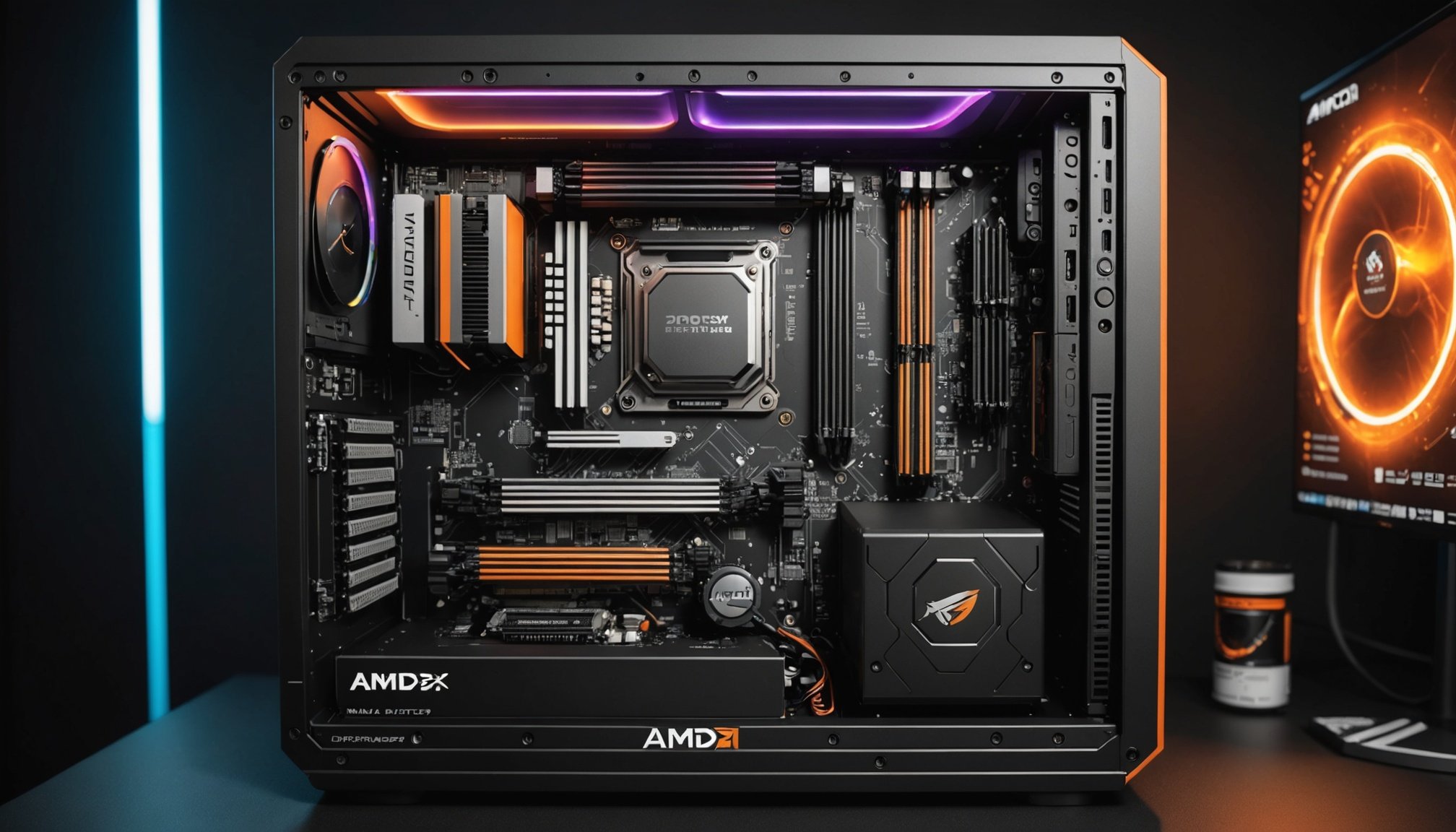Building the Ultimate High-Performance 3D Rendering Workstation with AMD Ryzen Threadripper 3960X
Why Choose the AMD Ryzen Threadripper 3960X?
When it comes to building a high-performance workstation for 3D rendering, the choice of CPU is paramount. The AMD Ryzen Threadripper 3960X stands out as a powerhouse in this domain, offering unparalleled performance and versatility. Here’s why it’s the ideal choice for your 3D rendering needs.
Core and Thread Count
The Ryzen Threadripper 3960X boasts an impressive 24 cores and 48 threads, making it a behemoth for multi-threaded applications like 3D rendering, video editing, and scientific simulations. This high core count enables extreme multitasking and parallel processing, significantly reducing render times and enhancing overall productivity[3].
Also read : Top Strategies for Creating a Safe and Streamlined Home Automation System with Your Google Nest Hub
Performance and Applications
Threadripper CPUs are renowned for their exceptional performance in demanding workloads. The 3960X, with its Zen 2 architecture, offers a base clock speed of 3.8 GHz and a boost clock speed of up to 4.5 GHz. This translates into superior performance in render engines like Corona Render and Unreal Engine, as well as in applications such as Blender and Adobe After Effects[3].
Selecting the Right Components for Your Workstation Build
Building a high-performance workstation is not just about the CPU; it requires a harmonious balance of components to ensure optimal performance.
Also to discover : Ultimate Guide to Perfectly Optimizing Your Intel NUC for Seamless 4K Streaming with Kodi
Motherboard
Choosing the right motherboard is crucial. For the Ryzen Threadripper 3960X, you need a motherboard that supports the sTRX4 socket. Look for motherboards with robust power delivery, multiple PCIe lanes, and ample USB and SATA ports. The ASRock TRX40 Creator or the ASUS ROG Zenith II Extreme are excellent choices, offering the necessary features and stability for a high-end workstation[3].
RAM and Memory
For 3D rendering, ample RAM is essential. The Ryzen Threadripper 3960X supports up to 256 GB of DDR4 memory, but for most users, 64 GB or 128 GB of high-speed RAM (3200 MHz or higher) would be sufficient. Ensure that the RAM is compatible with your motherboard and consider using quad-channel memory kits for optimal performance[3].
GPU Rendering
A high-performance GPU is vital for GPU-accelerated rendering. The NVIDIA GeForce RTX 4080 or AMD Radeon RX 7900 XTX are top choices, offering significant performance boosts in render engines that support GPU acceleration. For example, in Blender, using a powerful GPU can reduce render times dramatically compared to CPU-only rendering[4].
Cooling and Power Supply
Cooling Solutions
The Ryzen Threadripper 3960X has a TDP of 280W, which requires a robust cooling solution to prevent thermal throttling. Consider using a high-end air cooler like the Noctua NH-U14S TR4-SP3 or a liquid cooling system such as the Corsair Hydro Series H115i RGB Platinum. These coolers can handle the thermal output of the 3960X, ensuring consistent performance even under heavy workloads[3].
Power Supply
A reliable power supply is critical for a high-performance workstation. Look for a power supply with at least 850W of power, preferably with an 80+ Gold or higher certification for efficiency. The EVGA SuperNOVA 850 GA, 80+ Gold 850W, or the Corsair RM850x, 80+ Gold 850W, are excellent options that provide stable power and high efficiency[5].
Building Your Workstation
Step-by-Step Guide
- Unpack and Prepare Components: Carefully unpack your CPU, motherboard, RAM, GPU, and other components. Ensure all anti-static precautions are taken.
- Install the CPU: Mount the Ryzen Threadripper 3960X onto the sTRX4 socket on your motherboard, applying a thin layer of thermal paste.
- Add RAM: Install your RAM modules into the compatible slots on the motherboard, ensuring they are securely locked in place.
- Install the GPU: Mount your GPU into the PCIe slot on the motherboard, connecting any necessary power cables.
- Connect Storage and Peripherals: Connect your storage drives (SSD and HDD) and peripherals (keyboard, mouse, monitor) to the appropriate ports.
- Install Cooling Solution: Install your chosen cooling solution, whether it be an air cooler or liquid cooling system, ensuring all cables are securely connected.
- Connect Power Supply: Connect the power supply to all components, ensuring all cables are securely connected and the power supply is turned off before connecting.
Optimizing Performance
BIOS Settings
Optimizing your BIOS settings can significantly enhance performance. Here are a few key settings to adjust:
- Enable XMP Profile: Enable the XMP profile for your RAM to run at its rated speed.
- Adjust CPU Settings: Adjust the CPU settings to allow for overclocking or to enable Eco Mode if you prefer lower power consumption.
- Set Fan Profiles: Set fan profiles to ensure optimal cooling under different workloads.
Software Optimization
Optimize your software to take full advantage of the Ryzen Threadripper 3960X:
- Use Multi-Threaded Applications: Use applications that are optimized for multi-threading, such as Blender, Adobe After Effects, and Corona Render.
- Update Drivers: Ensure all drivers are up-to-date, especially GPU drivers, to get the best performance.
- Monitor Performance: Use tools like HWMonitor or GPU-Z to monitor your system’s performance and temperatures.
Real-World Performance and Benchmarks
Rendering Performance
The Ryzen Threadripper 3960X excels in rendering tasks. Here’s a comparison of render times for different processors:
| Processor | Cores | Render Time (min) |
|---|---|---|
| TR 7980X | 64 | 10 |
| TR 7970X | 32 | 15 |
| TR 3960X | 24 | 20 |
| Intel Core i9 14900K | 24 | 30 |
As seen, the Threadripper 3960X offers significant performance advantages over Intel’s best desktop CPUs in multi-threaded workloads[3].
Benchmark Scores
Here are some benchmark scores to give you an idea of the 3960X’s performance:
- Cinebench R23 Multi-Core: The Ryzen Threadripper 3960X scores around 25,000 points, outperforming the Intel Core i9 14900K by a significant margin[4].
- Blender 4.2: The 3960X completes the Blender 4.2 benchmark in under 10 minutes, showcasing its prowess in rendering tasks[1].
Practical Insights and Actionable Advice
Budgeting
When building a high-performance workstation, budgeting is crucial. Here’s a rough breakdown of what you might expect to spend:
- CPU: $1,300 – $1,500
- Motherboard: $300 – $500
- RAM: $200 – $500
- GPU: $1,000 – $2,000
- Cooling Solution: $100 – $300
- Power Supply: $150 – $300
- Storage and Peripherals: $500 – $1,000
Total estimated cost: $3,550 – $6,100
Future-Proofing
To future-proof your workstation, consider the following:
- Upgradeable Components: Choose components that are easily upgradable, such as the motherboard and RAM.
- Latest Technologies: Ensure your components support the latest technologies like PCIe 4.0 and DDR4 memory.
- Scalability: Opt for a power supply and cooling solution that can handle future upgrades.
Building a high-performance 3D rendering workstation with the AMD Ryzen Threadripper 3960X is a wise investment for anyone involved in demanding computational tasks. With its exceptional core count, high clock speeds, and robust architecture, this CPU delivers unparalleled performance in rendering, video editing, and other multi-threaded applications.
Quotes from Experts
- “The Ryzen Threadripper 3960X is a beast for multi-threaded workloads, offering performance that is hard to match in the desktop CPU market,” says a PC Guide reviewer[4].
- “For professionals, the Threadripper Pro offers even more capabilities, supporting larger memory capacities and additional PCIe lanes, making it ideal for handling massive datasets and running multiple GPUs,” notes an article on ComputerCity[3].
By following this guide, you can create a workstation that not only meets but exceeds your performance expectations, ensuring you stay ahead in the competitive world of 3D rendering and professional computing.











